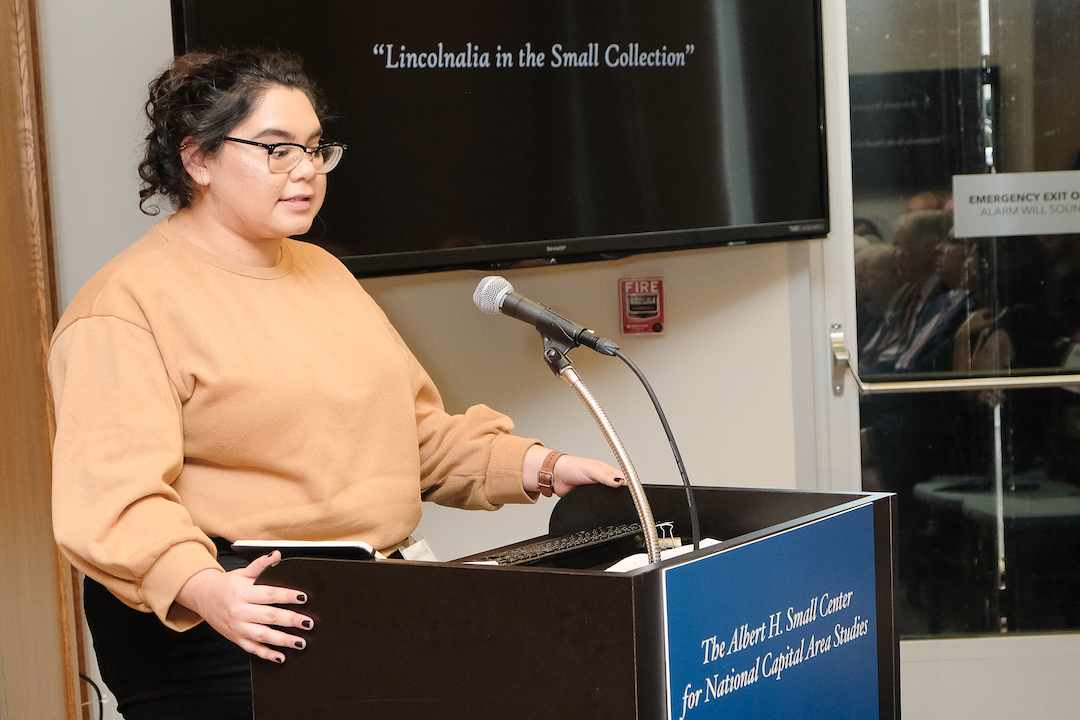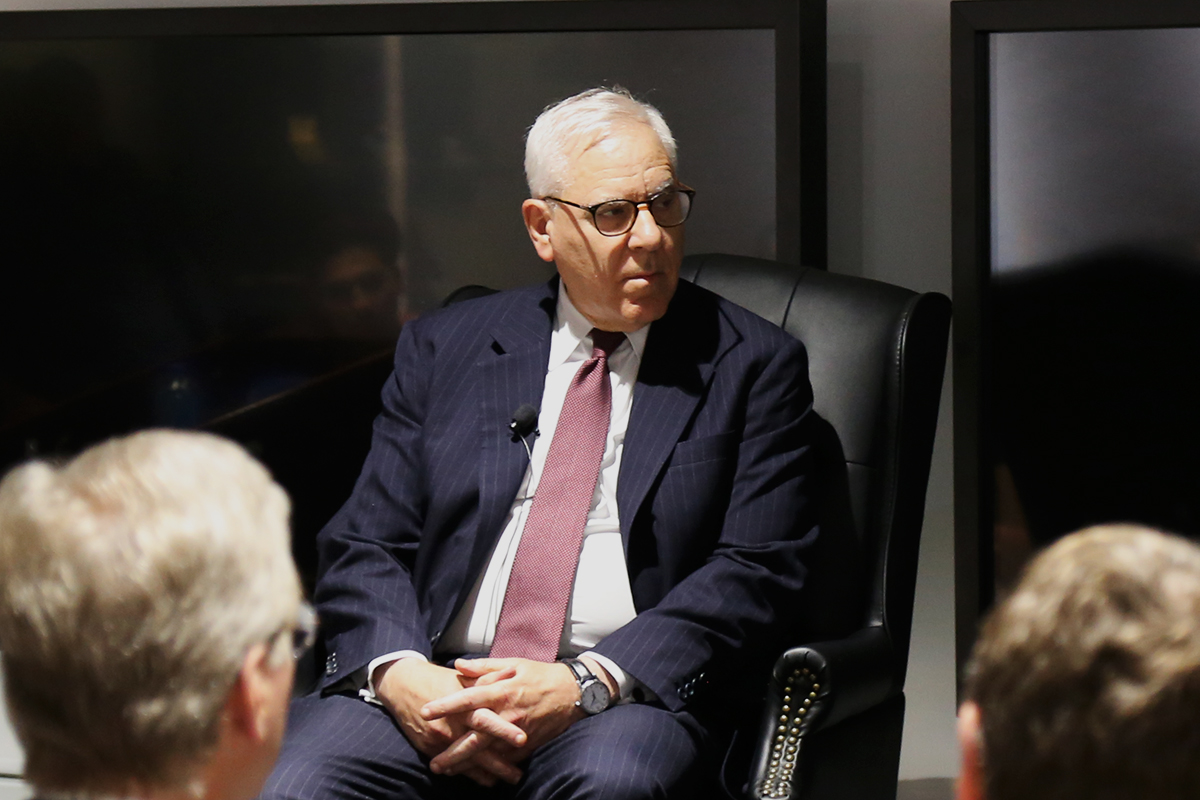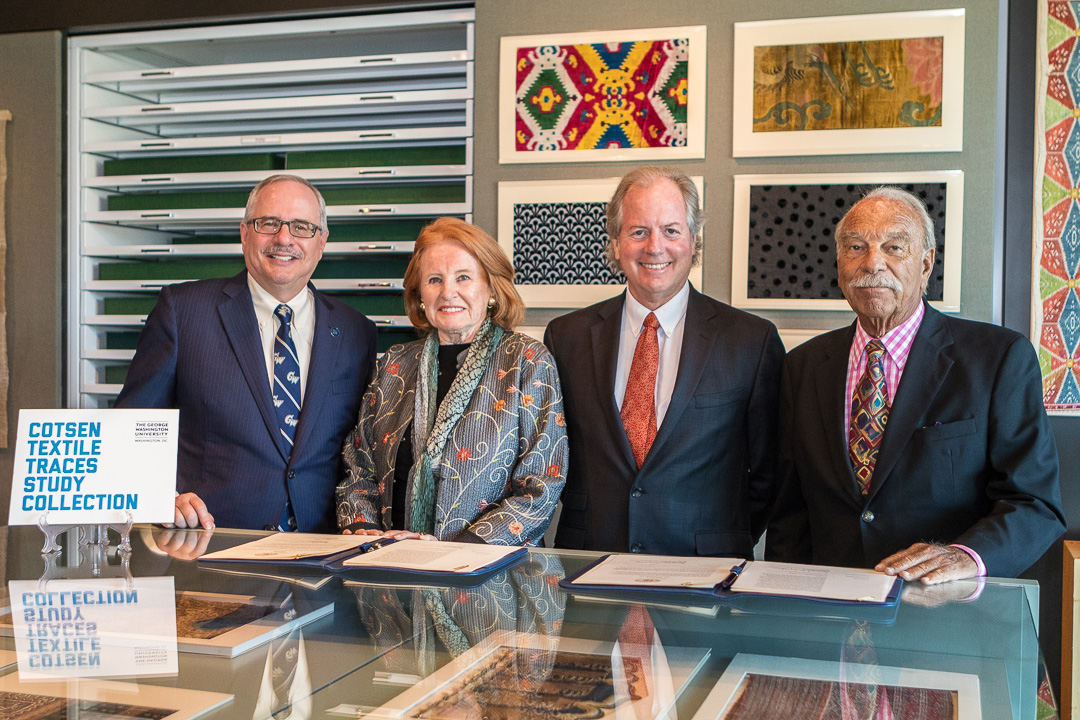By Tatyana Hopkins
As lithographers attempted to document the hospitals, forts and cities where soldiers were stationed during the Civil War, they also prompted interest among private citizens who paid to have their mansions recorded among churches, courthouses and other prominent buildings along a print’s border, said James M. Goode, Ph.D. ’95, curator of the Albert H. Small Collection at the George Washington University Museum and The Textile Museum during the collection’s annual symposium.
Dr. Goode said this mindset eventually encouraged the movement of bird’s eye view compositions as artists began documenting the nation’s developing cities.
“As the trains advanced through the West, artists went to local newspapers, told the editor they were going to do a print of their town or their city, and they advertised them,” he said. “The artists went door-to-door through the town making individual sketches of the buildings—hundreds of sketches—and they estimated the heights they wanted to look down on and composed a bird's eye view.”
He said between 1800 and 1910, most cities had as many as four of the hand-drawn bird’s eye view lithograph prints illustrating each of its buildings and roads, because they changed so quickly during the time period.
Dr. Goode made his remarks Tuesday at the annual Albert H. Small Symposium.
In 2011, Mr. Small, president of Southern Engineering Corporation and a third-generation Washingtonian, donated his extensive Washingtoniana collection to the university to help establish the George Washington University and The Textile Museum.
This philanthropy also led to the creation of the Albert H. Small Center for National Capital Area Studies, which allows students, faculty and other scholars to conduct research using the comprehensive collection, and the symposium showcases how GW students and staff use the vast collection in their research.
Each year students research items of the collection’s more than 1,000 manuscripts, books, newspapers, maps and photographs to develop exhibition labels for gallery display.
This year, two students took a deep look at individual artifacts to draw conclusions about the implications of the history of Washington, D.C.
“One of the focuses of the Albert H. Small Center for National Capital Area Studies is working with students and letting them get their hands dirty and work with the objects themselves,” said Amber Streker, M.A. ’18, assistant curator for the collection.
GW senior Anayeli Nunez researched two artifacts related to the assassination of President Abraham Lincoln, including an 1865 poster printed by the Department of Warrants offering a $100,000 reward for the apprehension of John Wilkes Booth and two of his accomplices, John H. Surratt and Daniel C. Harrold, whose images all were featured on the print.
She noted that photographs were rarely used in wanted posters because of printer limitations.
“So, the fact that we can see them here is very indicative of the severity of the crime and the urgency to find these people,” she said.
She also examined the history behind an 1865 photograph by Alexander Gardener depicting a group of spectators at the execution of four conspirators in Mr. Lincoln’s assassination.
“One of the most interesting aspects of this photo, aside from the sheer nature of the photo depicting death, are the group of people you can see in the bottom corner,” she said. “They were selected and invited to spectate the event.”
By researching the two artifacts, Ms. Nunez said, she was able to get a broad understanding of “an incredibly significant event in D.C. history.”
“I feel the pieces I worked on illuminated a very specific story within U.S. history, particularly one of how we define justice and whether or not that definition has evolved,” she said.
Likewise, graduate student Samuel DeWitt Pfister said he was able to consider how social history developed over time as the nation grew by looking deeply at the record of two artifacts.
Mr. Pfister researched a 1791 letter from then-Secretary of State Thomas Jefferson charging French engineer and architect Peter L’Enfant with the task of designing the nation’s new capital in Washington, D.C., and a 1792 letter from President George Washington submitting Mr. L’Enfant’s plan to Congress.
“The history of the design of the city was fraught with difficulty and drama,” he said.
He said Mr. L’Enfant’s design for the city, inspired by wide Parisian boulevards “validated the fears of many anti-federalists concerned with the physical concentration of federal power in a very bourgeoning city” and that over the next eight years the plan changed “time and time again.”
“It was also further indicative of some of the policies that have governed U.S. expansion of the next century—that is the displacement of indigenous populations for federal land use,” he said. “The city outline we see today is almost a derivative of L'Enfant's original plan.”
In his research, Mr. Pfister discovered that D.C. was built on the former land of the Piscataway Indian Nation, and years before the development of the federal city, the indigenous group had been pushed of land along the Potomac River and in Maryland to develop lucrative tobacco and grain plantations.
“Perhaps it’s only fitting that this land was chosen for the construction of a government whose founders had spent a century enslaving indigenous populations and dismantling their culture and for the next century continued to disenfranchise and marginalize them as they pushed them off their lands further,” he said.
He said the letters are a “testament that the city that we see around us today was once nothing more than a small step in the cautious development of the United States.”
Special adviser to the museum and former GW trustee Bob Perry, B.S. ’70, thanked Mr. Small, who was celebrating his 93rd birthday, for his contribution that has allowed students to engage in intensive research for nearly 10 years.
“Student interpretations energize a collection,” he said. “They bring this [collection] to life.”
In addition to showcasing student research, this year’s symposium was also an opening for the “Eye of the Birds: Visions and Views of D.C.’s Past,” which will feature two panoramic landscape paintings by artist Peter Waddell that capture city planner Mr. L’Enfant’s original vision for the city, and its actual development at the time of his death in 1825.
The project took two years and a team of researchers, including Ms. Streker, to complete.
The first landscape painting captures Mr. L’Enfant’s ambitious plan for complete with a canal through modern-day’s Constitution Avenue, cascading water fountains and wide boulevards for grand processions. The second bird’s eye view depicts how little progress was actually made at the time of his death, showing a White House under renovation and an underdeveloped National Mall where people grew wheat, fed cows and dumped trash.
“The paintings are by no means the last word, but what I hope will be a step toward understanding a little examined period of D.C. history,” Mr. Waddell said.




